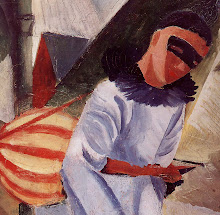Let's continue our meander through the statue garden of Rome, shall we? Last time, I trudged out some pictures of the city's heroic statues, while making a few observations and dissents from the aesthetic theories of Walter Pater. This time around, I have nothing so heady in mind: while I still have a theme, I have no theoretical axe to grind. Rather, I will merely focus on pictures of sculptures that embody the holy. (Yes, the next installment will focus on the profane.) Pack your Baedeker and let's get going!
The Holy
 Halfway down the Piazza Navona sits the resplendently Baroque church of Sant'Agnese in Agone. In one chapel stands this statue of Saint Sebastian - immediately recognizable, of course, by the host of arrows that penetrate his body. I don't know when this statue was created, or by whom, but I was taken by its naturalism, and the striking juxtaposition of calm repose and physical agony captured in the work.
Halfway down the Piazza Navona sits the resplendently Baroque church of Sant'Agnese in Agone. In one chapel stands this statue of Saint Sebastian - immediately recognizable, of course, by the host of arrows that penetrate his body. I don't know when this statue was created, or by whom, but I was taken by its naturalism, and the striking juxtaposition of calm repose and physical agony captured in the work. The Ponte Sant'Angelo, originally built by Hadrian, spans the Tiber in the shadow of the Castello Sant'Angelo. Along the rails stand ten Baroque statues of angels, holding instruments of the Passion. This statue - created by Antonio Raggi, a student of Bernini's - appears to be holding a chess piece, but in fact is holding a throne. This statue, and the others on the bridge, are a delight to photograph, out as they are in the clean Roman light.
These three statues are in the Castel Sant'Angelo itself. (The picture in the middle was included in my previous post on Rome's statues.) The marble statue, of the Archangel Michael, is by Rafaello da Montelupo, active in the 16th century; it originally sat at the top of the fortress itself. In 1753, however, after suffering damage, it was replaced by the bronze statue, executed by the Flemish artist Peter Anton von Verschaffelt. The bronze work, I feel, is far more striking and dramatic, and therefore more fitting for its perch - although the calm visage of Rafaello's statue brings to mind Michelangelo's David. It can still be seen in a courtyard in the fortress.
A delightful, multicolored stoup in St. Peter's, near Michelangelo's Pietà.
The Pietà itself. I wish this picture were better, but it is hard to get close to this, perhaps the most famous sculpture in St. Peter's.
A very animated depiction of Saint Veronica, in St. Peter's. This statue is part of the shrine to Saint Veronica. She carries, of course, the shroud that was reputedly used to wipe the face of Christ as he carried the cross through Jerusalem.
This is a very old statue, also in Saint Peter's, of Saint Peter Enthroned, reputedly created in the late 13th century by Arnolfo di Cambio. For centuries, pilgrims have rubbed Peter's left foot as they walk by. In the second picture, I join in this ancient tradition.
The nave of Saint John Lateran, the official cathedral of Rome, is lined with enormous statues of the Apostles, all dating from the early 18th century. This one is Saint Matthew, by Camillo Rusconi. One wonders what he is reading that seems to shock him so.
In a building across the street from Saint John Lateran are the Scala Santa (Holy Steps), said to be the very stairs in Pilate's palace that Christ climbed several times on his way to meet his fate. For centuries, pilgrims (myself included) have climbed the steps on their knees, praying as they go. These three statuary groups can be found at the base of the steps. They depict, in order: Christ's agony in the garden of Gethsemane, Judas' betrayal of Christ, and Pilate presenting Christ before the people of Jerusalem ("Ecce Homo").
The steps are marble but are covered with wooden planks for their protection. At various points, however, holes are left open in the wood; these indicate, it is said, the places where flecks of Christ's blood could be found. I didn't notice any blood as I peered through the little holes.















No comments:
Post a Comment